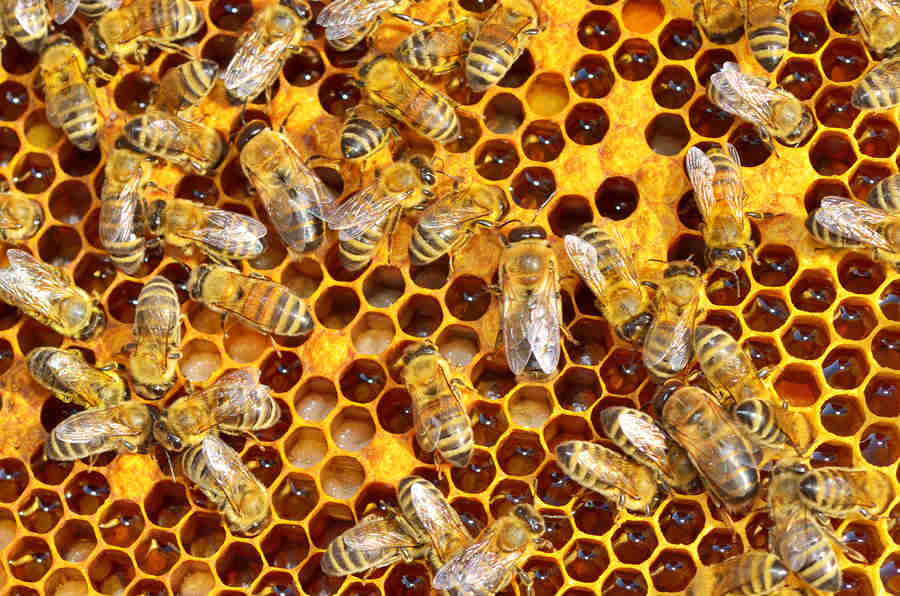Our Essential Friends…
Say the word “bee” and most people think of either honey bees or bumble bees. The truth is, there are many kinds of bees–almost 3,500 species in North America.
Many of our local bee species are solitary. Solitary bees build and tend their own nests without help from other members of the species. Solitary bees may be seen nesting in the stems of plants, in holes in stone or wood, or in the ground. Solitary bees are often overlooked and rarely sting people.
Other bees, including the honey bee and bumble bees, are social–living in nests or hives built communally by a colony. Social bees sting, but usually only in defense of their nest. Honey bees are not native to North America, but were brought to the country with some of the earliest settlers.
Despite recent, dire-sounding news reports, wild honey bees remain abundant throughout Texas and the U.S.
When ordering live bees, they should be secured in a leakproof container, taped, and placed with absorbent material in secondary leakproof bag or container. Secondary bag is then placed in sturdy padded box for shipment with identification form.

ORDERING: How live bees are shipped

CARPENTER BEES with their many body hairs, are excellent pollinators

OSMIA, A SPECIES OF MASON BEE
is a highly beneficial pollinator

HONEY BEE With Pollen Covered Legs And Abdomen

LEAFCUTTER BEES cut leaves for nest-making
[divider]
F@ctSheets on bees
-
Bumble bees Larger than a honey bee, yellow and black in color, these are our only native social bees. They nest in the ground and will sting.
-
Carpenter bees Similar in appearance to bumble bees, but hairless on the top of the abdomen, carpenter bees are known for the round holes they chew in wood to make their nests.
-
Honey bees – Control in and around homes (E-346) Honey bees can become pests when they nest in or around homes. Control involves nest removal.
-
Honey bee swarms and their control One of the most interesting honey bee behaviors, swarms elicit both fear and fascination. This publication explains when bee swarms should be left alone, and what to do when they cannot.
-
What to do if attacked by bees? Four things to remember, but the most important is “run!”
-
Submitting honey bee samples for identification (Ent-3007). Note: Due to budget cuts, the Texas Honey Bee ID laboratory closed in June, 2011. There is currently no longer any service providing identification of Africanized honey bees in Texas, so this publication is discontinued.
[divider]
Beekeeping Groups
Many people are fascinated by bees and want to become hobby beekeepers. Texas has a state beekeepers association and a number of local chapters that make it easy to become a beekeeper. Check out these sites for more information on beekeeping clubs and events in your area (I have separately listed specific sites for clubs in the north Texas area).
-
Texas Beekeeping Association A member-based organization representing commercial and hobbyist beekeepers, as well as scientists, educators and other individuals interested in the promotion and preservation of honey bees and beekeeping in Texas. The site maintains links over 20 beekeeping clubs and groups in the state, so if none of the sites listed below are a fit for you, check here.
-
Collin County Hobby Beekeepers My local group in Collin County, Texas, this active club meets on the second Monday of each month at 6:30 p.m. at the Heard Craig Center in McKinney, TX.
-
Harris County Beekeeper’s Association Established in 1908, this group meets meets at 7:00 P.M. on the 4th Tuesday of each month in Pasadena, TX.
-
Trinity Valley Beekeepers Association Meets on the first Wednesday of each month at Eastfield College in east Dallas.
-
East Texas Beekeeper’s Association This group meets on the first Thursday of each month at Tyler Jr. College (West Campus) in Tyler, TX
___
Source:
http://citybugs.tamu.edu/factsheets/biting-stinging/bees/
___
Content and copyright permission generously granted by:
Austin Grow Green: www.growgreen.org, who works in close association with:
Texas AgriLife Extension Service: http://agrilifeextension.tamu.edu
Marjory Wildcraft is an Expedition Leader and Bioneer Blogger with The [Grow] Network, which is an online community that recognizes the wisdom of “homegrown food on every table.” Marjory has been featured as an expert on sustainable living by National Geographic, she is a speaker at Mother Earth News fairs, and is a returning guest on Coast to Coast AM. She is an author of several books, but is best known for her “Grow Your Own Groceries” video series, which is used by more than 300,000 homesteaders, survivalists, universities, and missionary organizations around the world.







